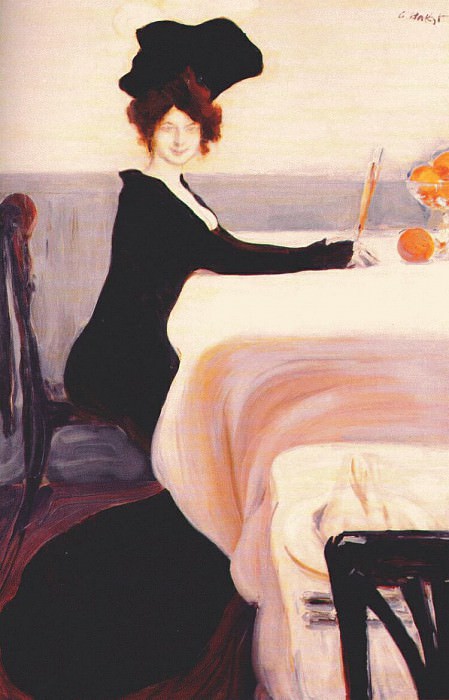supper 1902 Leon Bakst
Leon Bakst – supper 1902
Edit attribution
Download full size: 750×1170 px (0,1 Mb)
Back to album: Leon Bakst
One day two artists united by friendship and affinity for the World of Art group, Leon Bakst and Valentin Serov, enjoying the view of the streets of Paris at night, decided to go into a cafe. In the farthest corner sat a woman whose portrait Bakst did not fail to draw on a napkin. She was Anne Kyd, wife of the founder of the World of Art, Alexandre Benois. Well, it’s a small world... Especially in Paris of those years, which attracted the creative elite from other countries, including Russia. The painting, transferred from a napkin to a canvas, did not go unnoticed among critics, alas, not always in a favorable mood.
Description of Leon Bakst’s painting Dinner
One day two artists united by friendship and affinity for the World of Art group, Leon Bakst and Valentin Serov, enjoying the view of the streets of Paris at night, decided to go into a cafe. In the farthest corner sat a woman whose portrait Bakst did not fail to draw on a napkin. She was Anne Kyd, wife of the founder of the World of Art, Alexandre Benois. Well, it’s a small world... Especially in Paris of those years, which attracted the creative elite from other countries, including Russia.
The painting, transferred from a napkin to a canvas, did not go unnoticed among critics, alas, not always in a favorable mood. "The thing is unbearable!" burst out at the sight of the canvas from Vladimir Stasov, a renowned art connoisseur. It would seem, though, that there is nothing shocking in the painting: more than the traditional theme of a bored stranger, the impressionistic manner of painting. Had there been a couple of joyful men sitting next to the woman the painting might have resembled the works of Toulouse-Lautrec and other impressionists. However, Bakst not only captures what he sees, but also seeks to transform it.
The main motif of the painting is the dynamics of the outlines of the environment and the female figure itself, achieved by the successful juxtaposition of the rhythm of the white and blue planes, the edges of the tablecloth and the lady’s undulating dress in the lower part of the painting. Then the movement comes to a standstill, as if it collides with an invisible obstacle. The stranger’s hands, her face and her hat, the disproportion of which makes you think of a flower bud, are already on the same line.
The artist also uses a play of color built on the interchanging of the lady’s hair and oranges, which was done as if to spite Serov’s realistic approach in his "Girl with Peaches". Bakst leaves the woman’s face as if unfinished, which allowed him to emphasize the mystery and intangibility of this lady, juxtaposed with a sensual beauty that can reach the point of viciousness.
Кому понравилось
Пожалуйста, подождите
На эту операцию может потребоваться несколько секунд.
Информация появится в новом окне,
если открытие новых окон не запрещено в настройках вашего браузера.
You need to login
Для работы с коллекциями – пожалуйста, войдите в аккаунт (open in new window).














You cannot comment Why?
The table before her holds a sparse arrangement: a single fork rests on a linen cloth, and a bowl containing fruit is visible to the right. The background is indistinct, suggesting an interior space with limited depth, painted in pale yellows and creams that contribute to the overall sense of quietude.
A notable aspect of the work is its deliberate lack of narrative detail. There are no other figures present, and the setting remains ambiguous. This absence fosters a feeling of isolation and introspection. The womans expression is difficult to read; it conveys neither overt joy nor sadness, but rather a certain detachment.
The color palette reinforces this mood. The dominance of muted tones – the dark dress contrasting with the pale background – creates a sense of restraint and formality. The limited use of brighter colors, such as the orange hues in the fruit bowl, serves to highlight specific elements without disrupting the overall somber atmosphere.
Subtly, the painting seems to explore themes of solitude, societal expectations, and perhaps even a quiet rebellion against conventional domesticity. The womans posture and gaze suggest an individual consciousness that exists apart from her immediate surroundings. The sparseness of the table setting implies a rejection of ostentation or superficiality. Ultimately, the work invites reflection on the inner life of its subject and the complexities of human experience within a defined social context.